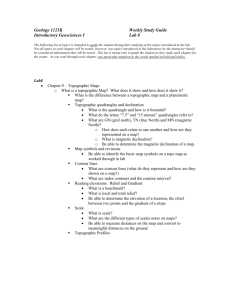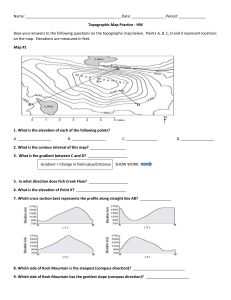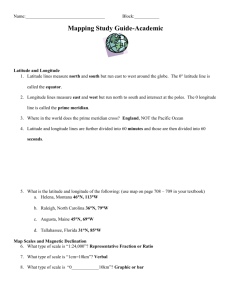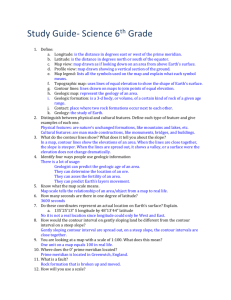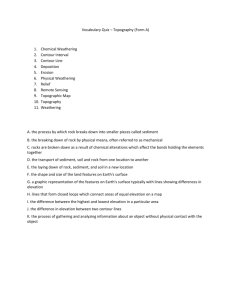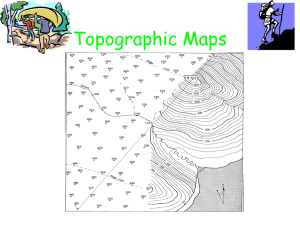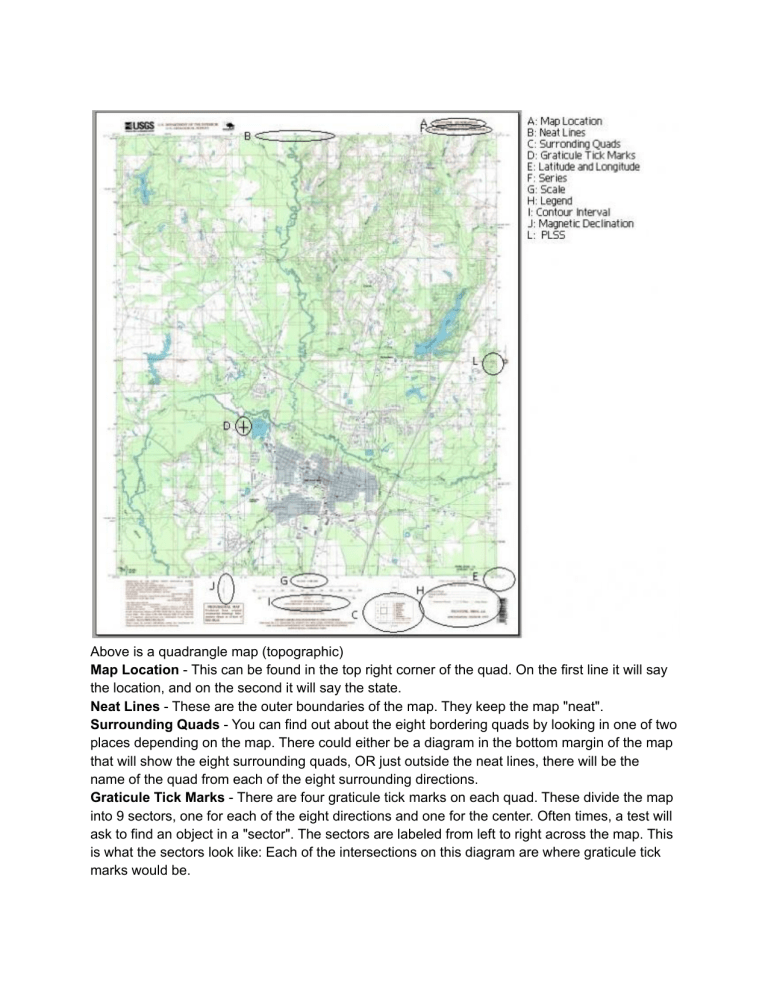
Above is a quadrangle map (topographic) Map Location - This can be found in the top right corner of the quad. On the first line it will say the location, and on the second it will say the state. Neat Lines - These are the outer boundaries of the map. They keep the map "neat". Surrounding Quads - You can find out about the eight bordering quads by looking in one of two places depending on the map. There could either be a diagram in the bottom margin of the map that will show the eight surrounding quads, OR just outside the neat lines, there will be the name of the quad from each of the eight surrounding directions. Graticule Tick Marks - There are four graticule tick marks on each quad. These divide the map into 9 sectors, one for each of the eight directions and one for the center. Often times, a test will ask to find an object in a "sector". The sectors are labeled from left to right across the map. This is what the sectors look like: Each of the intersections on this diagram are where graticule tick marks would be. Latitude and Longitude - Latitude and Longitude measure the distance north and south of the equator, and east and west of the prime meridian, respectively. They can be broken down into three increments: The most basic form, degrees, are identified by a small “o” following and above a number (80°). Degrees can be broken down into minutes. There are sixty minutes per degree. Minutes are identified by an apostrophe (80°15’). They can be broken down into seconds. Likewise, there are sixty seconds per minute. Seconds are identified by two apostrophes (80°15’30’’). Always be as specific as possible when writing latitude and longitude measurements. ● Latitude measures distances North or South of the equator. It is important to put either an N or an S after the coordinates, or you will be penalized. To calculate the latitude of a location, take the distance from the lower sector boundary to the target object (preferably in mm) and divide it by the N-S distance across sector (in mm) and multiply this value by 150. This is the distance to the target object in seconds. Then, you can simply derive the value of the degrees from the bottom neat line, and add the number of seconds you have measured. A latitude might look like this: 39°45'30"N. ● Longitude measures distances East and West of the prime meridian. As with Latitude, it is important to label E or W after the coordinates, or points will be taken off. Longitude can be calculated by taking the distance from easterly sector boundary to the target object (preferably in mm) and dividing it by the E-W distance across sector (in mm), then multiplying that answer by 150. This is the distance to the object in seconds as well, so it's important to take the longitude from the eastern sector boundary, and add the number of seconds you measure. A longitude might look like this: 110°39'25" W. Series - Most quads used in Road Scholar use the 7.5 minute series. 7.5 minutes of lat/long Scale - Most quads used in Road Scholar have a scale of 1:24,000. Both scale and series are common questions on tests, so be sure to know the right answer. There may be some tests (but very few), however, in which a quad of a different series and scale will be used (e.g. a 30 minute x 60 minute series of scale 1:100,000). Legend - This can be found in the bottom right corner of the quad. This may show important information on how to read the quad, for example, it may explain what types of roads are featured on the map. Contour Interval - This is found in the center of the bottom margin of the quad. This number indicates the number of feet (or, rarely, on some maps, meters) between each contour line. If you're finding the elevation of something, you must look at the contour interval first. In addition, like series and scale, many tests will ask what the contour interval is. Unlike series and scale, however, this number may vary widely across maps. ● Contour Lines are lines throughout the map that indicate the elevation of a location. Combined with the contour interval, you will be able to find the elevation of every point on the map through contour lines. ● Index Contour Lines - These dark contour lines will also display the elevation. They are extremely important when calculating elevation. Magnetic Declination - There is a diagram located at the center of the bottom margin of the quad. This diagram will have three (sometimes two) lines coming out of it. The one straight up is true north. One of the other two will say MN. This is magnetic north. The magnetic declination is the number of degrees between true north and magnetic north, and it is written right next to the line as MN. Geographic Declination - This will be the other line in the diagram mentioned above. The geographic declination is the number of degrees between true north and geographic north, and it is written next to the line at GN. Public Land Survey System (PLSS) - For many tests, teams will be asked to write out a location using PLSS. This may seem difficult to write at first, but it’s easy to figure out with practice. First, identify the township and range of the target object or section. If you look on the neat lines of the quad, you will see something that might say "T. 5 S" and "R. 5 E". T stands for township and R stands for range. Be sure to get the right township and range, because this will be needed later. Within each of these divisions, there are 36 sections, usually outlined by orange borders. The number of the section can be found on the quad in the center of the section. Finally, each section can be split into four quarters: NE, NW, SE, and SW. Within each of those quarters there can be another four quarters, once again being NE, NW, SE, and SW. Locate which 1/16 (that is, a quarter of a quarter) the point is in, i.e. NW ¼ of the NE ¼ or SW ¼ of the SW ¼. More specific measures may also be asked for in tests, but questions generally do not ask for more than two or three specifications. Now you have all the information to write a full PLSS location. First, start with the 1/16 the point is in; for example, SE ¼ NW ¼. Then, add the section number to the end (SE ¼ NW ¼ 20). Finally, add township and range that were on the quad to the end: SE ¼ / NW ¼ / 20 / T 6 S R 8 W. Congratulations, you have successfully written out your location in PLSS form! Please note that not all states use PLSS so not all quads have PLSS on them. Additional Information A chart showing many of the topo symbols There is much more to learn about topographic maps besides the above. The following elements are not mentioned on the example map, but still important. Map Colors - Major colors on a topographic map include: black, blue, brown, green, red, and purple, each with a different meaning. Black can denote features like roads and buildings, blue identifies water features, brown identifies contours, green identifies vegetation, red denotes important roads, and purple indicates revisions to the map. Map Symbols - The map symbols needed during the event can be found here. It is very important to have at least one symbols sheet during the competition. Many questions will ask about certain symbols, and having a symbols sheet is practically an unwritten law for the build-a-map portion of the test. An example of a topo sheet is on the right. Survey Control Marks - These are specific points on a quad that give the exact elevation of a place that is not found on a contour line. Teams need to know control station marks, spot elevations, and benchmarks. The symbols for each of these can be found in the topographic map symbols booklet. Azimuth - Azimuth is the degrees from one object to another. This is found using a full circle (360) protractor. An azimuth can be up to 359 degrees, and it looks like this: 25°. It is important to line up the protractor so that 0 is facing north. Then, use a ruler or other straightedge to find the exact degree measure between the two places. Bearing - Bearing is also found by using a full circle protractor. The direction N or S is added in front of the degrees, and E or W is added afterward. It looks like this: N 25° E. Like an azimuth, it is important to use a ruler or string to find the exact degrees. 0 degrees is always facing north or south, and 90 degrees is always facing west or east. Bearing can only be measured from 0 to 90 degrees, since it is always measured from the 180 degree line. For example, if the angle is 91 degrees (in the sense of an azimuth), than the bearing measurement would be S 89 degrees E. Measuring Distances - To measure distances on a quadrangle, you'll need a piece of scrap paper. Line up the piece of paper between the two objects placing a small dash where each of them are. Then, bring the piece of paper down to the map scale in the bottom margin. Line up the piece of paper with the proper scale to measure how long of a distance the line represents. If the space between the two dashes is larger than the measurement line, make another dash where the end of the line is. Then, measure to as exact a distance as possible. Stream Gradient - Stream gradient is found in feet per thousand feet, or ft/1000 ft. To find stream gradient, first measure the length section of the stream in question. Then, figure out the change in elevation between the beginning and ending points of the portion of the stream. Input these amounts into the formula "change in elevation o ver distance x 1000" (C.I.E/Distance x 1000) to find the answer. String is needed for this to accurately find the distance along the stream/river. Slope Gradient - Similar to stream gradient, use the formula "change in elevation over distance x 100" to find the answer. This measurement, however, is along a straight line and the method mentioned in the Measuring Distances section can be used to calculate the distance instead of a string. Stream Flow Direction - The contour lines located on the stream will always point upstream. For example, if the contour line is pointing NW, the stream will be flowing to the SE. Inset Map - A smaller map that is focused on a smaller area, these are usually larger cities or places that require more details. Many times, these are used on the Road Scholar test as regular vocabulary or as a place you may want to focus on. Geologic time refers to the vast expanse of time over which the Earth has existed and undergone its various changes. The geologic time scale is a system of chronological measurement that divides Earth's history into named units of time, such as eons, eras, periods, and epochs. The units of the geologic time scale are determined by the rock formations and fossils found in the rocks, which provide a record of the Earth's history. The oldest division of geologic time is the Precambrian eon, which extends from the formation of the Earth, about 4.6 billion years ago, to the beginning of the Cambrian period, about 541 million years ago. The Precambrian eon is divided into three eras: the Hadean, Archean, and Proterozoic. The next division is the Phanerozoic eon, which began with the Cambrian period and continues to the present. The Phanerozoic eon is divided into three eras: the Paleozoic, Mesozoic, and Cenozoic. The Paleozoic era is characterized by the diversification of marine invertebrates, the emergence of fish, and the colonization of land by plants and animals. The Mesozoic era is characterized by the rise of dinosaurs and other reptiles, as well as the emergence of birds and mammals. The Cenozoic era is characterized by the evolution of mammals, including primates and humans. Each era is further divided into periods, such as the Triassic, Jurassic, and Cretaceous periods of the Mesozoic era. The periods are in turn divided into epochs, such as the Holocene and Pleistocene epochs of the Cenozoic era. Rock and mineral identification is the process of determining the type of rock or mineral that a sample is composed of. This can be done through a combination of visual observation and laboratory testing. To identify a rock or mineral, geologists use a combination of its physical properties, such as color, texture, and crystal structure, as well as chemical properties, such as composition and hardness. Physical Properties: ● ● ● ● ● Color: The color of a rock or mineral can be an important characteristic for identification, but it can also be deceiving as many minerals can occur in a variety of colors. Luster: The way a rock or mineral reflects light is called luster. It can be metallic or non-metallic. Hardness: The hardness of a rock or mineral is measured by its resistance to scratching. The Mohs scale of mineral hardness is a commonly used tool for this purpose. Specific gravity: Specific gravity is the ratio of the density of a mineral to the density of water. Crystal habit: The shape of the crystals in a mineral is called its crystal habit. Chemical Properties: ● ● ● Composition: The chemical composition of a rock or mineral can be determined through techniques such as X-ray diffraction and X-ray fluorescence. Acid test: Minerals that contain carbonate will effervesce (fizz) when in contact with a drop of dilute hydrochloric acid. Streak: The streak of a mineral is the color of the powder left behind when a mineral is scratched against a streak plate. To practice rock and mineral identification, geologists often use a rock and mineral identification kit, which contains samples of common rocks and minerals, and a set of tools such as a hand lens, streak plate, and scratch test tools. At a college level, the study of plate tectonics includes a more in-depth understanding of the processes that drive plate movement and the mechanisms by which plate boundaries form and evolve. The driving force behind plate tectonics is the convection of the Earth's mantle. The heat generated by the radioactive decay of elements in the Earth's core causes the rock in the mantle to become less dense, and rise to the surface, where it cools and becomes denser. This denser rock sinks back down into the mantle, creating a circulating system of convection. This convection is thought to be responsible for the movement of the lithosphere, with the colder, denser plate sinking into the mantle at subduction zones, and the warmer, less-dense plate rising to the surface at mid-ocean ridges and hotspots. The type of plate boundary formed depends on the relative motion between the two plates. ● ● ● Divergent boundaries: occur when two plates are moving away from each other, and are characterized by the formation of new crust through seafloor spreading. The most important process at divergent boundaries is the upwelling of magma from the mantle, which cools and solidifies to form new oceanic crust. Convergent boundaries: occur when two plates are moving towards each other, and are characterized by the destruction of crust. This can happen when two continental plates collide, forming mountains, or when an oceanic plate collides with a continental plate, leading to the subduction of the oceanic plate beneath the continental plate. Subduction zones are characterized by the formation of a deep oceanic trench and a chain of volcanoes. Transform boundaries: occur when two plates are sliding past each other in a horizontal direction. These boundaries are typically marked by large faults, such as the San Andreas fault in California. These boundaries are characterized by the formation of strike-slip faults. Plate tectonics also play an important role in shaping the Earth's climate. The movement of plates can lead to the formation of mountains, oceanic trenches, and volcanic island chains, which can affect the planet's climate by altering ocean currents, atmospheric circulation, and the distribution of heat and moisture. Additionally, plate tectonics also plays a role in the distribution of natural resources, such as oil, gas, and minerals. Understanding plate tectonics is also important for understanding the causes of earthquakes, volcanic eruptions, and tsunamis, and for predicting where these hazards are likely to occur in the future. Topographic maps are maps that show the relief, or the three-dimensional shape of the Earth's surface, as well as other relevant information such as cultural and hydrographic features. They are created using a combination of field surveys, aerial photographs, and satellite imagery. The data collected is used to create a digital elevation model (DEM) which is used to generate contour lines that show the elevation of the land surface at different points. One of the key features of topographic maps is the use of contour lines, which are lines that connect points of equal elevation. The contour interval, or the difference in elevation between contour lines, is typically standardized and can vary depending on the area being mapped. Contour lines can be used to show the shape and slope of the land surface, as well as the location of valleys, ridges, and peaks. Topographic maps also include other types of information such as hydrographic features, such as lakes, rivers, and streams, as well as cultural features, such as roads, buildings, and boundaries. These features are typically represented using symbols, which are standardized to make them easy to interpret. Locating things on a topographic map can be done by using a combination of visual observation and reference to the map's legend and grid system. One way to locate things on a topographic map is to use the map's grid system, which is a network of lines that divide the map into a series of squares. The grid system is typically based on a geographic coordinate system, such as latitude and longitude, or a projected coordinate system, such as UTM (Universal Transverse Mercator) or State Plane. By determining the coordinates of a point on the map, it is possible to locate it on the map. Another way to locate things on a topographic map is to use visual observation, which involves looking at the features on the map and identifying them in relation to other known features. This can be done by looking at the shape and location of landforms, such as mountains and valleys, as well as the location of roads, trails, and other man-made features. Additionally, topographic maps often include a legend or a key which provides information about the symbols used on the map and their meaning. This can help to identify different types of features, such as roads, buildings, and bodies of water. In summary, locating things on a topographic map can be done by using a combination of the map's grid system, visual observation and the legend or key. It's important to be familiar with the map's grid system and symbols to be able to correctly identify and locate the features. Additionally, practicing with different types of maps and using multiple sources of information such as aerial photographs or satellite imagery will help to improve your ability to locate things on a topographic map. Aerial photographs are images of the Earth's surface taken from an aircraft or satellite. In the context of the Science Olympiad event Road Scholar, aerial photographs are used as a tool for interpreting the Earth's surface features, such as landforms, vegetation, and human-made structures. Aerial photographs can be taken using a variety of cameras and platforms, including aircraft, balloons, kites, drones, and satellites. The type of camera and platform used will affect the resolution, coverage area, and acquisition time of the photographs. When interpreting aerial photographs, it is important to consider the scale, orientation, and perspective of the photograph. Scale refers to the relationship between the size of the features on the photograph and their actual size on the ground. Orientation refers to the direction that the photograph is facing, and perspective refers to the angle at which the photograph was taken. Aerial photographs can be used to identify a variety of Earth surface features, such as: ● ● Landforms: such as mountains, valleys, and plateaus, can be identified by their shape, shadow, and texture. Vegetation: such as forests, grasslands, and crops, can be identified by their color and pattern. ● Human-made structures: such as roads, buildings, and mines, can be identified by their shape, size, and pattern. Aerial photographs can also be used in combination with other types of data, such as topographic maps, to create more detailed and accurate interpretations of the Earth's surface. To prepare for the Science Olympiad event Road Scholar, students should practice interpreting aerial photographs, and learn how to identify different types of Earth surface features. This can be done by studying aerial photographs of different areas, and comparing them to topographic maps and other types of data. Additionally, it is helpful to understand the different types of cameras, platforms, and techniques that are used to acquire aerial photographs, as well as the characteristics and limitations of different types of aerial photographs. Geologic cross-sections are graphical representations of the subsurface geology of an area, showing the distribution and relationships of different rock formations and geologic structures at different depths below the surface. These cross-sections are used to understand the geology of an area and the processes that have shaped it. Geologic cross-sections are typically created by combining information from a variety of sources, such as surface mapping, drilling data, geophysical surveys, and borehole data. The process of creating a cross-section involves interpreting this data and constructing a three-dimensional model of the subsurface geology. Cross-sections are typically created using specialized software, which allows for the manipulation and analysis of the data. The resulting cross-section can be presented in a variety of formats, such as a two-dimensional cross-section, or a three-dimensional model. The information contained in a geologic cross-section can be used to understand a variety of geologic processes, such as: ● ● ● ● Stratigraphy: the sequence and distribution of rock layers, and the relative ages of different rock formations Structural geology: the shape and orientation of different rock formations and geologic structures, such as faults and folds, and the processes that have created them Hydrogeology: the distribution and properties of subsurface water resources, such as aquifers and groundwater flow patterns Geohazards: potential hazards related to geological processes such as landslides, earthquakes and volcanic eruptions At a college level, the study of stratigraphy is a branch of geology that focuses on the interpretation of the sequence and distribution of rock layers, and the relative ages of different rock formations. Stratigraphy is a fundamental tool for understanding the geologic history of an area and the processes that have shaped it. Stratigraphy is based on the principle of superposition, which states that in a sequence of undisturbed rock layers, the oldest layer is at the bottom and the youngest layer is at the top. This principle forms the foundation for the development of relative dating techniques, which allow geologists to determine the relative ages of rock layers without knowing the absolute ages. One of the key techniques used in stratigraphy is the study of fossils. Fossils are the remains or traces of ancient life that are preserved in rock layers. By studying the fossils found in different rock layers, geologists can determine the relative ages of the layers and the environments in which they formed. Another important technique used in stratigraphy is the study of stratigraphic sequences, which are sequences of rock layers that have been deposited over time. Stratigraphic sequences can be used to reconstruct the geologic history of an area and to understand the processes that have shaped it. At a college level, the study of stratigraphy also includes the use of advanced techniques for data collection and analysis, such as sedimentology, which is the study of the formation, composition, and properties of sedimentary rocks, and geochronology, which is the study of the absolute ages of rocks and minerals. In summary, stratigraphy is a fundamental tool for understanding the geologic history of an area and the processes that have shaped it. At a college level, students are expected to have a deep understanding of the principles and techniques used in stratigraphy, and to be able to apply them to interpret the geologic history of an area. Additionally, students are expected to be familiar with the most recent research and advancements in the field of stratigraphy. Sedimentology is the study of the formation, composition, and properties of sedimentary rocks, and it is an important branch of geology that is closely related to stratigraphy. Sedimentary rocks are formed from the accumulation and lithification of sediment, which can include a wide variety of materials such as clay, sand, gravel, and organic matter. These rocks can be classified based on their composition, such as clastic or non-clastic rocks, and based on their textures, such as fine-grained or coarse-grained rocks. Sedimentologists study the properties and characteristics of sedimentary rocks in order to understand the depositional environment in which they formed, such as rivers, lakes, oceans, deserts, or wetlands. By studying the sedimentary structures, such as bedding, cross-bedding, ripples, and mud cracks, sedimentologists can infer the direction and strength of the depositional current and the energy level of the depositional environment. Sedimentologists also study the composition of sedimentary rocks in order to understand the provenance of the sediment, or where it came from. This can be done by studying the mineralogy and petrography of the rock, as well as the fossils it contains. Geochronology is the study of the absolute ages of rocks and minerals. It is an important tool for understanding the chronological relationships between different rock layers and geologic events. There are several different techniques used in geochronology, including: ● ● ● ● Radiometric dating: the use of the decay of naturally occurring radioactive isotopes to determine the absolute age of a rock or mineral. Stratigraphic correlation: the comparison of the relative ages of rock layers in different areas to establish a chronology. Paleomagnetism: the study of the magnetic properties of rocks and minerals to determine the Earth's magnetic field at the time the rock was formed. Dendrochronology: the study of tree rings to determine the absolute age of trees and the age of the wood they are made of. In conclusion, sedimentology and geochronology are both important branches of geology that are used to understand the formation and history of the Earth's surface. Sedimentology deals with the study of sedimentary rocks and the depositional environment that formed them, while geochronology deals with the absolute ages of rocks and minerals, as well as the chronological relationships between different rock layers and geologic events. Understanding these concepts and techniques is crucial for interpreting the geologic history of an area and the processes that have shaped it. Azimuths and bearings are related concepts that are used to describe the direction of a line or object in relation to a reference point. Azimuth is a term used to describe the direction of an object in relation to true north, measured in degrees clockwise from true north. It is typically used in navigation and astronomy. For example, an azimuth of 90 degrees would indicate that an object is due east of the reference point. Bearing is a term used to describe the direction of an object in relation to magnetic north, measured in degrees clockwise from magnetic north. It is typically used in navigation, surveying and mapping. For example, a bearing of 180 degrees would indicate that an object is due south of the reference point. It's important to note that the difference between true north and magnetic north can vary depending on location, as the magnetic field of the Earth is not aligned with its rotational axis. This difference is known as magnetic declination, and it must be taken into account when using azimuths and bearings. In practical usage, azimuths and bearings are used to determine the direction of a line or object, such as a road, a trail, or a landmark in relation to a reference point, such as a map or a compass. They can also be used to determine the direction of travel, or to navigate to a specific location. To prepare for the Science Olympiad event Road Scholar, students should practice using azimuths and bearings to determine the direction of different objects and to navigate to specific locations. Additionally, they should be familiar with the concepts of true north, magnetic north, and magnetic declination, as well as the difference between azimuths and bearings, and the best practices of using them. Magnetic declination is the angle between true north and magnetic north. It is the difference between the direction a compass needle points and the direction to true north. The direction to true north is represented by the geographic North Pole, while the direction to magnetic north is represented by the magnetic North Pole. This difference can vary depending on location, as the Earth's magnetic field is not aligned with its rotational axis. There are several different formulas that can be used to calculate magnetic declination depending on the level of accuracy required and the information available. One commonly used formula to calculate magnetic declination is the "Isogonic formula", which is based on the location's latitude and longitude and the current year. The formula is: Magnetic Declination = (Year - 2020) * W + (D + E) - (G + H) Where: W = rate of change of declination per year D = declination at the reference date E = annual equation of the center G = annual equation of the equinoxes H = annual nutation of the pole Another commonly used formula is the "Magnetic Field Model" formula, which uses a model of the Earth's magnetic field to calculate magnetic declination. The formula uses the location's latitude, longitude and altitude as input parameters, and it's more accurate than the Isogonic formula. There are also online calculators and maps which can be used to determine the magnetic declination for a specific location. These resources can provide declination information based on the location's latitude and longitude, and often on the date as well. It's important to note that, Magnetic declination can change over time, so it's recommended to check for the most recent and accurate data for your location. Additionally, it's also good practice to use a compass and map together when navigating, and to be familiar with how to adjust for magnetic declination. Interpreting a highway map involves understanding the different types of information that are presented on the map and how to use them to navigate and plan a route. 1. Legend or Key: The map's legend or key provides information about the symbols used on the map and their meanings. This can help to identify different types of features such as roads, bridges, rest areas, and landmarks. 2. Scale: The scale of the map indicates the relationship between the size of the features on the map and their actual size on the ground. This can help to determine distances and estimate travel times. 3. Grid system: The map's grid system, such as latitude and longitude or UTM (Universal Transverse Mercator) coordinates, allows you to locate a specific point on the map and to navigate. 4. Road Classification: Different types of roads are represented by different colors and symbols on the map, and these symbols indicate the level of service that can be expected, such as the width of the road, the presence of traffic lights, and the frequency of exits and intersections. 5. Elevation: Maps of mountainous or hilly areas may include contour lines which indicate the elevation of the land surface at different points. These can be used to determine the steepness of the terrain and to identify potential obstacles or hazards. 6. Points of Interest: Maps may also include symbols or labels for points of interest such as tourist attractions, parks, and historical sites. 7. Distance markers: Many highway maps include distance markers along the routes, these markers help you to estimate the distance between two points, and the remaining distance to your destination. 8. Additional information: Some maps may include information such as rest areas, gas stations, and other services.

